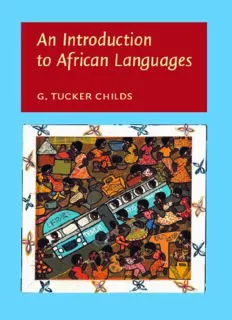
An Introduction to African Languages PDF
Preview An Introduction to African Languages
<DOCINFOAUTHOR""TITLE"AnIntroductionintoAfricanLanguages"SUBJECT""KEYWORDS""SIZEHEIGHT"220"WIDTH"150"VOFFSET"4"> AnIntroductiontoAfricanLanguages An Introduction to African Languages G. Tucker Childs PortlandStateUniversity JohnBenjaminsPublishingCompany Amsterdam(cid:1)/(cid:1)Philadelphia TM Thepaperusedinthispublicationmeetstheminimumrequirements 8 ofAmericanNationalStandardforInformationSciences–Permanence ofPaperforPrintedLibraryMaterials,ansiz39.48-1984. LibraryofCongressCataloging-in-PublicationData Childs,GeorgeTucker AnIntroductiontoAfricanLanguages / G.TuckerChilds. p. cm. Includesbibliographicalreferencesandindexes. 1.Africanlanguages.I.Title. PL8005 .C45 2003 496-dc22 2003060704 isbn9027226059(Eur.)/158811421X(US)(Hb;alk.paper) isbn9027226067(Eur.)/1588114228(US)(Pb;alk.paper) ©2003–JohnBenjaminsB.V. Nopartofthisbookmaybereproducedinanyform,byprint,photoprint,microfilm,or anyothermeans,withoutwrittenpermissionfromthepublisher. JohnBenjaminsPublishingCo.·P.O.Box36224·1020meAmsterdam·TheNetherlands JohnBenjaminsNorthAmerica·P.O.Box27519·Philadelphiapa19118-0519·usa <TARGET"toc"DOCINFOAUTHOR""TITLE"Tableofcontents"SUBJECT""KEYWORDS""SIZEHEIGHT"220"WIDTH"150"VOFFSET"4"> Table of contents Acknowledgementsanddedication ix Preface xi Abbreviations xv ListofMaps xvii ListofFigures xix ListofTables xxi 1. Introduction 1 1.1 ReasonsforstudyingAfricanlanguages(cid:2)5 1.2 HistoricalbackgroundtothestudyofAfricanlanguages(cid:2)14 2. TheclassificationofAfricanlanguages 19 2.1 Thefourphyla(cid:2)21 2.2 ApproachestoclassifyingAfricanlanguages(cid:2)31 2.3 “Megalocomparison”ormasscomparison?(cid:2)38 2.4 Andthentherewerethree:MergingNilo-Saharan andNiger-Congo(cid:2)42 2.5 Somelocalproblemsinlanguageclassification(cid:2)44 3. Phoneticsandphonology 55 3.1 Clicks(cid:2)56 3.2 Nasalprocesses(cid:2)61 3.3 Other“exotica”(cid:2)65 3.4 Syllablestructure(cid:2)66 3.5 Vowelharmony(cid:2)68 3.6 Consonantalternation(cid:2)73 3.7 Tone(cid:2)76 vi Tableofcontents 4. Morphology 97 4.1 Non-concatenativemorphology(Afroasiaticandelsewhere)(cid:2)97 4.2 Nounclasssystems:ThemanygendersofAfrica(cid:2)99 4.3 Verbalmorphology(cid:2)103 4.4 Verbextensionsandargumentstructure(cid:2)110 5. Syntaxandsemantics 117 5.1 Languageatexpressiveplay:Ideophones(cid:2)118 5.2 Predicatestructure(cid:2)124 5.3 Negation(cid:2)128 5.4 Movement:Verbfocus/predicateclefting(cid:2)132 5.5 Serialverbs(cid:2)137 5.6 Agreementphenomena:Animacyrulesandthingsfallapart(cid:2)141 5.7 ConsecutivetenseandswitchreferenceinSupyire(cid:2)145 5.8 Syntaxanddiscourse:Logophoricity(cid:2)147 6. Historicalandtypologicalissues 153 6.1 Electronicresources(cid:2)153 6.2 Languagetypologyandhistoricallinguistics(cid:2)154 6.3 Diachronictypology/grammaticalization(cid:2)155 6.4 Languageandhistory(cid:2)164 6.5 Linguistics,archaeology,andDNAanalysis:The“newsynthesis”(cid:2)170 7. SocialeffectsonthelanguagesofAfrica 175 7.1 Languagesofrespect,andotherspecialvarieties(cid:2)176 7.2 Languagecontactphenomena(cid:2)188 7.3 Pidginsandcreoles(cid:2)203 Appendices 217 References 223 Index 261 <TARGET"ack"DOCINFOAUTHOR""TITLE"Acknowledgementsanddedication"SUBJECT""KEYWORDS""SIZEHEIGHT"220"WIDTH"150"VOFFSET"4"> Acknowledgements and dedication ThisbookisdedicatedtothevictimsofcivilwarsandotherstrifeinAfricaand toallofthebereavedfamilymembersleftbehind. Theacknowledgmentsaremany,forthebookhasbeenalongtimeinthe making.Severalsetsofstudentsweregraciousenoughtowadethroughworking versionsofthebookattheUniversityoftheWitwatersrand,theUniversityof Toronto,PortlandStateUniversity,theUniversityofFreiburgandl’Université deKankan. Ihavebeenluckyenoughtohavemanytalentedandenthusiasticteachers, colleagues, students, collaborators, and friends, who have contributed in different ways (in alphabetical order): Kofi Agorsah, Niyi Akinnaso, Abdel- KaligAli,FelixAmeka,LouiseBedichek,LionelBender,RogerBlench,Eyamba Bokamba, Pascal Boyeldieu, Raymond Boyd, George Brooks, Mamadou Camara,RectorSeydoubaCamara,VickiCarstens,FaridaCassimjee,IvyCele, Chacha N. Chacha, France Cloarec-Heiss, Bernard Comrie, Bruce Connell, Denis Creissels, Naomi Cull, Chris Culy, Katherine Demuth, Keith Denning, BoubacarDiallo,GerritDimmendaal,JeanDoneux,DavidDwyer,Genevieve Escure, Nick Faraclas, Marie-Paule Ferry, Rosalie Finlayson, Bill Fischer, Zygmunt Frajzyngier, Orin Gensler, Joseph Greenberg, Wili Haacke, Masaa HenryHallie,BerndHeine,BobHerbert,LarryHutchinson,JohnHutchison, LarryHyman,LarryJohnson,LaminJabbi,MattKaaya,JimmyKhumalo,Fallah Lambert Kamano, Raimund Kastenholz, Nikki Keach, Maurice Keifar, John Kingston, Chuck Kisseberth, Martin Klein, Fred Lamp, Jim Laesch, Tom Larsen, Will Leben, Ian Maddieson, Omen Maduka, Tamba Mayson, Fayia McCarthy, Sam Mchombo, Lemmy L. Meekisho, Saa Millimouno, Maxime Millimouno, Yves Moñino, Lioba Moshi, Maarten Mous, Salikoko Mufwene, Mukoe, Lynne Murphy, Carol Myers-Scotton, Moses N. Ndorbor, Philip Neswiswi,PaulNewman,JohannaNichols,DumisaniKhrushchevNtshangase, RidwanNytagodien,JohnOhala,EfuaOsamu,DorisPayne,FrankSengiangndo Pittman,FatherJosephParcell,KonstantinPozdniakov,GeorgePoulos,Hank </TARGET"ack"> viii AnIntroductiontoAfricanLanguages Rogers, Paulette Roulon-Doko, Mahamad Sabo, Bill Samarin, Thilo Schade- berg, Russ Schuh, Guillaume Segerer, John Victor Singler, Ron Schaeffer, Carolyn Smallwood, John Stewart, Anne Storch, Chief Tamba Taylor, Paul Fayia B. Tengbeh, Tony Traill, Erhard Voeltz, Valentin Vydrine, Mike Ward, JosphatWaruhiuandAndréWilson. Thefollowinggrantsandawardingagencieshaveaidedintheresearchand productionofthisbook:FulbrightLecturerAward,Guinea(2000);theBremer StiftungfürKultur-undSozialanthropologie,Germany(1999,2000);Deutsche Forschungsgemeinschaft(1998);CollegeofLiberalArtsandSciences,Portland StateUniversity;1997–98;SocialSciencesandHumanitiesResearchCouncilof Canada (1994–96); CSD, Pretoria (1993); Council Grant, University of the Witwatersrand, Johannesburg (1993); University of California at Berkeley (1988); Foreign Languages and Area Fellowship (1981–82; 1987); Fulbright- Hayes Doctoral Research Grant (1983–84); Humanities Graduate Research Grant(1983);NationalResourceFellowship(1982–83). <TARGET"pref"DOCINFOAUTHOR""TITLE"Preface"SUBJECT""KEYWORDS""SIZEHEIGHT"220"WIDTH"150"VOFFSET"4"> Preface The primary goal of this book is to provide an introduction to the linguistic studyofAfricanlanguages.Theorientationadoptedthroughoutthebookisa descriptive-structural-typological one, as opposed to a formal-theoretical approach. Formalisms are not eschewed per se but rather are invoked when theyaidthecentralthrustofthebook,whichistodescribeandcharacterizethe languages of Africa in a succinct and concise manner, and to make the facts accessible to the unfamiliar reader. To say that the approach is typological meansthatagivenstructureiscomparedtostructuresofthesametype(typical- ly ones familiar to readers), set within an established range of variation, and characterized as usual or unexpected. Further detail is also provided, where possible,thestructure’ssynchronicdistributionanddiachronicorigin.Thetext assumes at least some knowledge of language structure on the part of its readers,butnothingbeyondthatacquiredinafirst-yearlinguisticscourse. Thebookisorganizedbylinguisticdomainorsub-fieldwithinlinguistics, and each of the chapters can be read independently. Readers can thus read selectively or read the book sequentially from cover-to-cover. Instructors can use the book as a text for a course in African languages or even language typology. There is generous indexing and an expansive table of contents; Appendix2containswidelyusedalternativenamesforthelanguagesdiscussed anddirectsreaderstolistingsinthelanguageindex. ForeachlinguisticdomainIprovideanoverviewoftherelevantphenome- na,selectinginparticularfeaturesthatareuniquetoAfricaoratleastrobustin Africa and unusual in languages of the world. At the least I have chosen phenomenathataredifferentfromthelanguageinwhichthisbookiswritten andfromitsclosecongenersinEurope.Exemplificationisdrawnfromawide rangeoflanguages,muchofitdrawnfrommyownworkandteachingexperi- encesbutsomeofitdrawnfromsecondarysources. Anotherimportantgoalofthisbookistointerestthereaderbyintroducing the reader to some of the fascination and even to some of the controversy
Description: